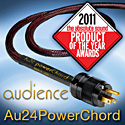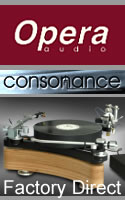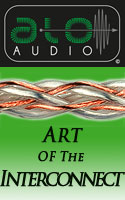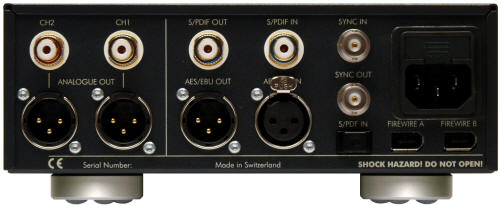|
|
You are reading the older HTML site
Positive Feedback ISSUE 59
weiss DAC202 as reviewed by Nicholas Bedworth
Introduction While some places have quiet weeks, Switzerland has quiet centuries. After William Tell drove out the despotic German overlords in the late middle ages, life in der Schweiz has proceeded in its unique, measured and rather appealing way. Compared to the continuous din of life here in the tropics, where the birds seem to be calling out "More, morrre…", waterfalls thunder in the distance, and continuous, refreshing zephyrs rustle the luxuriant foliage, Switzerland generally has refreshingly low levels of noise, except perhaps for the infernal klonking of cow bells... The country's legendary manufacturing and engineering skills produced its days of fame as a watch making power, long gone, as well as the iconic audio brands of Revox, Studer and Nagra. More recently, such high-end Swiss design firms as Weiss Engineering, Ltd., located in Uster, as well as darTZeel and Soulution, among others, have continued the country's tradition of standard-setting technology and market leadership. My own memories and impressions of Switzerland—having lived in several parts of the country over the years—often revolve around sounds, perhaps because the inherent quietness of the place makes them all the more noticeable. These recollections were refreshed one afternoon in a rather surprising way, as the late Karl Haas, on his wonderful syndicated radio program Adventures in Good Music, played several eclectic recordings made during his own trips there. Out of my Honda Element's most definitely mid-fi FM radio came the persistent, droning and clanging of the church bells and chimes that peal for forty-five minutes every Sonnabend (Sunday eve, meaning Saturday at sunset). These mournful, sometimes oppressive, tones transported me to days long past, perhaps thirty-five years before, in the remote, ski-resort town of Arosa, in Graubünden. It was déjà vu all over again when a few minutes later, Haas announced that Arosa was in fact the venue. Instead of promoting the ephemeral values of the youth culture, the bells seem to say, "Beware, if today was bad, tomorrow may be worse, and anyway, Winter is coming". Switzerland is, of course, well-known for its conservative attitudes towards just about everything, which may not be such a bad thing. In any event, it would be hard to forget those plaintive tones ringing out, echoing and slowing fading away across an elemental landscape of silvery Alpine peaks, snow-filled forests and the cerulean sky. Out of the box experience This high-Alpine silver-white-blue palette is reflected in the refined aesthetic Daniel Weiss applies across most of his products. His DAC202 is no exception, with its brushed aluminum front panel, dark gray cover and blue-on-white display, all conveying freshness, precision and clarity. As one would expect at this price point, the DAC arrives in a rather elegant, custom vinyl-over-heavy-cardboard, slip-cover presentation case. A subtle weave adds texture to the surface, emblazoned with stylized, minimalist version of the Weiss logo in silver foil. Inside, protected by a dark foam insert, the DAC and remote await. The mass of the DAC202 itself keeps the bottom part of the case in position as one slowly slides the cover up and off. The front panel, now also available in black, comprises an adjustable-brightness "blau mit weiss" LCD panel, a status lamp, one ¼" gold-plated TRS headphone jack, and the remote control IR sensor. There's also a large, smooth-as-silk, gently-detented multifunction rotary knob used most often for adjusting the attenuation, secondarily for selecting the input sources, operational modes and other less-commonly-used settings. Between the front panel and the remote control, the Weiss' "creature features" are well-thought-out and handsomely implemented. Except for the headphone jack, all other connections (dual FireWire; XLR and RCA analogue out; AES on XLR, S/PDIF on RCA inputs and outputs, TOSLINK digital in; BNC word clock sync in and out) are effected via the rear panel, which appears to be identical to that of the earlier DAC2.
Remote possibilities Some of the most outstanding elements of the Weiss user experience are the DAC202's remote controls. Controls? Plural? Well, yes. Firstly, there's the physical remote which, simply put, is the most agreeable one yet to rest on my palm; secondly, for computer-based sources that drive the Weiss over IEEE 1394, there's also a visual software control panel, or applet, that configures advanced features (in keeping with the firm's professional audio DNA) relevant to recording scenarios.
The hand-held remote is a marvel of simplicity and effectiveness. Way too many expensive audio products inflict bulky, cheap, generic, plastic remote nightmares on the hapless users; these parts-bin-de jour "creations" usually have so many buttons that it's nearly impossible to find the right one, which seems like the ultimate in inconvenience. Such products, combined with an otherwise advanced product, are a great way to show that the engineers rule the roost, and send the message that they really don't care about the consumer (the people who pay the rent). In contrast, the DAC202's remote has just ten buttons, and you'll use them all: There's a power button that commands the Weiss to turn on or go into standby; up and down volume arrows; mute; source and filter selectors; as well as my favorite "must have" button of all times, phase reversal. More than a few recordings—even some of the best ever made—are reversed polarity, and having the ability to change this on the fly is a boon: The Weiss has more than adequate performance to make the difference apparent. The powder-coated remote control "wand" is made from metal, and has the same shape as the Weiss INT 202 and 203 remotes. It fits easily into one's hand, and has just the right amount of heft. The gently-radiused contours and edges are very easy to live with over time. And the famous human opposable thumb, attached to the hand clutching the remote, can easily operate all the buttons regardless of one's chirality. The membrane switches used here have enough resistance that they can't be actuated accidentally, but don't require much force to toggle. The ergonomics are quite nicely done, but sonically, switching sources and polarity with the remote does inflict a slightly annoying "tick" upon one's ears. Over on the software side of the remote control equation, a spiffy Weiss FireWire I/O control panel application on, in my case, various Windows Vista and Windows 7 personal computers, grants access to key system integration features and operational controls; it also allows monitoring of FireWire interface latency and other operational parameters. This second "remote control" will see a lot of use in recording studio settings, less so for ordinary consumers, but making both available is one of the DAC202's many strengths. The applet is especially helpful for FireWire computer users, because, according to Weiss, it's the most reliable way to ensure that the sync sources and rates will be set reliably in the DAC: Using the front-panel control, sometimes things may get confused. The real-time latency indicator helps one detect transport "hiccups", and the driver software suggests which operational mode to use, given the actual, dynamic performance of the FireWire-DAC network. Buffer length, up to 2048 samples, is also selectable here. In addition to showing latency, the software control panel also displays "measured sample rate" data. The 48kHz-series sample rates are correct to the Hz: 48,000; 96,000 and 192,000. Somewhat oddly, the 44.1kHz series is not. The values vary here and there, and are usually several Hz off, for example: 44,122; 88,244; 176,805. Spectral measurements taken with the Audio Precision APx515 also provide evidence of slight deviations from the ideal. These are sometimes intentional and may prevent various "ringing" artifacts, depending upon the dynamics of the design. Putting it all together The Weiss DAC202 is exceptionally flexible and capable with respect to connectivity and integration. In addition to the prime application of the Weiss for stereo playback, for those considering this product as the nucleus of a home or project recording studio, there's very little that one can't do with respect to the routing of inputs and outputs, looping through 3rd-party equalizers, or mixing and matching sources with syncs. All kinds of unusual configurations and external devices such as digital signal processors (DSPs) are readily supported. While discussing these in any detail is beyond the scope of our work here, every single mode—more than a dozen—is clearly explained in the Weiss owner's manual. Everyone will appreciate the Weiss' much-appreciated ability to match the output of the DAC to the gain structure of the rest of the gear. The main analogue output "swing" can be set to 1.06V, 2.12 V, 4.15 V or even 8.15V RMS (on the XLR outputs) by the front panel rotary knob. Voltage values are half as much when using single-ended RCAs. These selectable output level ranges, in combination with the 60dB of digital attenuation available, enable the DAC to be mapped optimally to just about any and all downstream components. A completely separate subsystem manages headphone output, which is driven by its own set of DACs. For this application, the available levels are 0.2V, 0.9V, 2.7V and 5.2V RMS. If one changes amps, 'phones or speakers, which reviewers and many consumers do quite frequently, the Weiss will adapt in a moment. And for those who use a preamp instead of driving the amps directly, or have hardware or software attenuation ahead of the DAC, the attenuation capabilities may be bypassed entirely. What luxury! The Weiss does it all. These days, way too many recordings, in just about every genre, are mastered at levels that are exceptionally and unnecessarily high: Loud, louder and loudest seems to be the name of the game. Using a typical Reference Recording recording as the reference (as it were), let's say that -4dB digital attenuation generates full-scale loudness with a particular amp and speakers. With recordings from most other studios, one often hits full scale at -12dB, or even -15dB. Ouch! The Weiss offers 0.5dB steps for the first 20dB of attenuation, and then 1dB steps thereafter down to 60dB: If one starts out, so to speak, at -15dB, one runs out of fine 0.5 adjustments and hits the 1dB steps all too quickly. Assuming that the gain structure "likes" one of the 2, 4 or 8V outputs, it would be possible to drop down to a lower output swing and thus potentially regain more of the 0.5dB attenuation steps. For higher-gain gear that's already using the 1V output, well, you're out of luck, meaning one will be limited much of the time to 1dB attenuation. Critical DAC conversion clocking is equally flexible. It may be extracted from the incoming bitstream, for example S/PDIF; generated by Weiss' internal clock; another input modality; or an even an external 3rd-party "house clock" such as the Grimm CC-1 that can drive a 75Ω input at TTL levels. The FireWire input defaults to the DAC's internal clock (with the Weiss generating isochronous handshaking for the incoming bitstream), others to the source selected. Thus, most of the sources, the Weiss itself or an external clock can be "in charge" of the syncing. Furthermore, there's a TTL-level master word clock output as well, which can be used to control an upstream computer audio card or CD transport buffer. As the listening section reveals, very interesting and beneficial things can happen as one tweaks the inputs with various clock sources. The overall adaptability and flexibility of the DAC202 architecture is outstanding. There are few limitations, except perhaps for the TOSLINK handling no more than 96kHz sampling rates. Most consumers can live with that. And about the only operational issues that came to my attention were occasional instances in which the DAC was rather slow to sync up to the incoming bit streams. In this regard, the Weiss is definitely a bit "touchy". In comparison, the entry-level and much-less-expensive Bel Canto 1.5DAC, for example, synced to any input instantly, while the Weiss would sometimes thrash around for a few seconds before selecting and locking onto the correct rate. Rarely, it would refuse to sync at all, for reasons known only to itself. And, as mentioned earlier, from time to time, there would be spurious ticks and clicks when switching inputs, reversing the phase or changing other settings. Overall, these annoyances are nothing major, but it would be better if they didn't exist at all, given the price-point and exemplary build level. Regarding the life and times of IEEE 1394, a.k.a. FireWire, it has become a legacy interface, in that, apart from professional recording gear, only a tiny percentage of new computers supports it these days. This robust, generalized and sophisticated peer-to-peer networking protocol vanished from even high-spec Windows PCs a year or so ago, and may not be supported at all by Microsoft in Windows 8. On the Mac side of things, while Apple's most expensive laptops and workstations (which are sold in limited quantities) have FireWire, the handwriting is on the wall. Apple's worldwide market share of personal computers is still only 5%, where it has been for some time: The "footprint" of FireWire is indeed limited, and is declining. Daniel reminded me that on Windows desktop workstations, one can always add a FireWire interface card, which will work under Windows 7 with the drivers available for download from the Weiss Web site. The Mac version of the drivers is fully qualified under the "Lion" update to OS X. And interestingly, there is a FireWire ports on one of Apple's monitors, and that Thunderbolt to FireWire interfaces are available. So all is not lost with FireWire, but it's not as easy as it used to be. The reasons for this transition are both commercial and technical, chief amongst them being that for the simple job of streaming bits at the relatively slow-poke digital audio rates, USB is now more than adequate, and much easier for designers to implement. And after all, how long before hard-wired USB itself is replaced by various forms of wireless connection? One high-speed serial interface turns out to be enough. In the case of Windows, my venerable Toshiba Qosmio laptop, running Windows Vista, connected immediately to the Weiss via IEEE 1394 without any difficulty. Latency was typically a couple of milliseconds or less, and the link was quite reliable. However, even after a great deal of effort, none of my much newer, very-high-spec HP laptops running Windows 7, was able to stream successfully to the DAC202. My hunch is that the issue here is one of hardware compatibility or a driver bug; despite updating the drivers and "trying everything" (except, of course, the right thing), well, it never worked although all appearances (the device drivers installed without incident) were that it should. This is one of these situations where nobody has enough of a commercial interest at stake to take the time to fix it, so it simply stays broken. And often there are several "moving pieces" involved, with further complicates things. With Windows workstations, things would probably be easier, once one purchases and installs an appropriate FireWire interface. Bit transparency is quite easy to verify. After setting one's media player to an appropriate state, various test files supplied by Weiss are played back, and a front panel indicator gives a go-no-go response. If the test fails, keep in mind that generally, it's your own fault, and a little futzing about will identify the source of the problem. Bit-perfect problems are often caused the player or operating system inadvertently doing sample rate conversion, which may even happen as a consequence of upgrading a media player (e.g., iTunes). Or somewhere along the line, an attenuation control is inserted into the chain, or both. By making sure that DSP, volume leveling, etc., are also disabled, there shouldn't be any problems. In my case, the J. River Media Center, using the WASAPI and WASAPI Event output modes, worked perfectly. The Sound of Music A considerable amount of experimentation ultimately resulted in exceptionally musical, natural and emotionally engaging performance from the Weiss. There are a number of ways one may configure this DAC, and some combinations really do sound much better than others. If you make the extra effort and set up the DAC202 in a way that lets it reach its full potential, you'll be richly rewarded with wonderful sound, in which the inner detail of choruses, the character of the venues, and subtle nuances of timbre and vocal expression help one forget, at least for a while, the technology and enjoy the music. To scope out the envelope of the Weiss' performance, several high-power, solid-state amps—all monoblocks—ranging from the Klaus Bunge's Odyssey Kismets, to the lofty realm of the Technical Brain, the GTE Audio Trinity and Pass XA200.5, were pressed into service. Several other DACs and sources were also rotated through the system, including the entry-level Bel Canto 1.5, GTE Audio's ultra-high-end Trinity mono DACs, the exotic MSB Signature Platinum DAC IV, three FireWire-equipped laptops, various USB-S/PDIF transports, and the new and impressive MSB Universal Media Transport. The DACs and amps are connected with a variety of line-level cables, ranging from Musical Reference cryogenically-treated offerings from Silent Source Audio to the semi-divine Skys from AudioQuest; all this gear drives my trusty and well-broken-in Wilson Sashas via very short and also very revealing AudioQuest Wild Wood speaker cables. Over the course of several months, and after hundred of hours of conditioning, the true nature of Daniel Weiss' creation began to reveal itself. You, too, will hear all of its virtues as well, provided that the DAC is accompanied by refined speakers, high-end amps and cables, as well as fed with the best recordings. In this context, it can deliver musical delight, in quantity. Massed strings can be almost edgeless, as they should be, as well as engendering heart-melting delight. The music becomes completely engaging, and the suspension of disbelief begins to take hold. Most importantly, it's possible to simple relax into the sound, without any nagging distortions tugging at one's awareness. Think of a sonic performance that's effortless, palpable, organic. And at the same time, all kinds of detail emerge that one takes for granted in a live performance: There's the emptiness of the stage, in which a brave person is belting out the blues for all to hear; the sonic textures and surfaces, if you will, are no longer homogenized into an amiable blur. Flutes have punch, raspyness and focus as well. And choirs are a specialty of the Weiss. Wait until you hear the various groups of voices, each with their own musical lines, rising and falling within the overall fabric of the composition. Several recent reviews, in my opinion, failed to the bottom of the Weiss' considerable virtues, nor did they address its few shortcomings. In fact, the DAC202 is considerably more capable than what the rather casual observations of others might lead one to believe. While the Weiss DAC202 has been hyped to the heavens as the ultimate "computer DAC" by otherwise noble and intelligent persons, they incongruously chose to torment it with MP3 files. No thanks: Even through ear buds, the horrific distortions caused by this codec technology from Hell are readily apparent. Playing MP3 through quality gear, in my experience, reveals the demonic details in their full glory: Mushy bass, ragged transients; hollow, dry, sterile, "tight" timbres, just a whiff of a soundstage with cardboard images and no depth, and best of all, swirling, roiling whirlpools of noise over the entire presentation. Of course, some of these people also claim that "cables don't matter", either. But they do, enormously. Still other well-meaning and learned sorts assert the DAC202's FireWire "asynchronous" interface must have "low jitter", but provide supporting no measurements or 3rd-party data to this effect. Because the Weiss usually uses its own internal clocking as the default for FireWire sources, why would any inherent interface "jitter", high, low or otherwise, be particularly relevant? The FireWire source and data flow may be synced to the Weiss, rather than the other way around, so any jitter in the Weiss internal clock would most likely be the critical element. There's further conjecture and a "guess" that the supposed "low jitter" is the reason for the Weiss' "clarity" in the low-end, while listening through amps and speakers that don't have very much to offer in this regard. Daniel notes that the Weiss interface is capable of both asynchronous and isochronous operation simultaneously; they're not mutually exclusive: The isochronous interaction modes lets the Weiss "reserves" a certain amount of the FireWire interface bandwidth that other devices cannot usurp. My surmise is that this helps keep latency under control, which is probably more important for recording scenarios than for simple audio streaming. Given the Weiss' brand promise of excellence, as well as its substantial price, the DAC202 deserves more careful evaluation. On the other hand, while not attempting to defend the indefensible, it is certainly true that understanding the sonic capabilities of a richly-featured, complex, high-performance audio component such as the Weiss DAC202 isn't easy: One has to make a considerable effort to get to the bottom of what it's really good at, let alone getting a feel for whatever "issues" there may be. Through the Weiss with gun and camera… Let's get started on our "deep dive" by taking a look at several of the Weiss' broad range of inputs and clocking options, and the sonic experience each one delivers. First up, selecting the Weiss' internal clock and the S/PDIF input, along with upsampling filter A, with 44.1kHz recordings, the sound was a little grainy, with a little bite to the upper midrange. Overall, dynamics tend to be slightly constrained, and the soundstage is somewhat narrow and flat. However, by merely switching to filter B, the timbral balance smoothed out—no more bite—and the images immediately sported more realistic dimensions. The soundstage is broader, but with the music tending to be concentrated more towards the center. Switching from the Weiss internal clock to the incoming S/PDIF bit stream providing sync produced a significant, across the board improvement, especially when using sources with very low jitter or phase noise such as the Audiophilleo1 or MSB Universal Music Transport. Clearly, the sync source matters, and the Weiss is apparently happier extracting the clock from a high-quality source than using its own internal time base. The Weiss also has an external Word Clock input, and connecting this to a special-purpose "house clock", the Grimm CC-1 ($2495) engendered a sonic apotheosis: Suddenly and distinctly, there's an palpable increase in naturalness, extension and spaciousness. Before, it just didn't quite right; something was lacking. With the external clock, the music really comes alive, with greater soundstage depth and width, more realistic images, and the ability to visualize the space of the venue along with everything in it. The vulnerable, entrancing quavering of a well-trained female voice such Marni Nixon's reaches right into your heart. The sonics of difficult-to-reproduce flutes and harp strings were transformed from so-so to outstanding. Now we're most definitely having fun. With the Weiss thus in its full glory, at least to the extent it can be delivered by 44.1kHz recording, there's good layering of the soundstage from front to back, one can hear the varying reverb from the sides and rear walls. There's an interested illusion of looking into a diorama. Soundstage width is very good, but not spectacular (meaning it doesn't go way to the outside of the speakers). The overall tonal balance is neutral or perhaps a touch to the warm side; it's definitely not cold, dry or analytical. One can listen for hours without fatigue. The images are perhaps more definite and concentrated than in real-life, but this is a rather subtle consideration. Like so many other DACs, it turns out that in this case as well, the Weiss' inputs are most definitely not all created equally. As usual, the AES and S/PDIF sound best, followed by the TOSLINK and, in this case, FireWire, rather than the usual laggard on many competing DACs, the USB input. In contrast to the findings of others, FireWire, at least when driven by the Qosmio laptop, was definitely not better than the AES or S/PDIF inputs: Feeding bit streams with known, very-low jitter in them, and allowing the Weiss to extract the clock from them, definitely produced better results than using FireWire managed by the DAC202 internal clock. In comparison to the AES and S/PDIF inputs at their best, the Qosmio's FireWire synced internally always seemed a little rounded off, congealed, gritty, tight, and occasionally, hard in the upper midrange. The AES inputs had lower noise and greater background detail. But once again, combining the FireWire input but using the Grimm external master clock yielded major improvements: From being a bit on the dull and obtunded side, timbres slid slightly upwards—delivering a sense of increased purity, focus, and accuracy. The TOSLINK input was pretty much the same story: It sounds better than the FireWire input synced with the Weiss internal clock, but not as well as the AES and S/PDIF inputs fed by the MSB UMT transport or the Audiophilleo. Typically, in my experience, even when using quality glass optical fibre interconnect, TOSLINK tends to be a little soft, reduced in detail, less air, and overall, smoothed out, but in a euphonic manner: More whump, less grip, but not too bad. And, as one might expect by now, when clocked with the Grimm, even humble TOSLINK perked up considerably. Using high-resolution source material, meaning 88.2kHz sampling rates and faster, and 24-bit samples, introduced a kind of ease and edgeless-ness across a wide range of musical genres. And once again, the external clock made a significant positive difference, although perhaps not as marked as when listening to 44.1kHz music. Tweaking the Weiss with conical "feet" helps considerably, and experimenting with the new Synergistic Research MIG "mechanical interface grounds" is also fruitful. With the MIGs, you'll find it's possible to adjust the degree focus, ambience, liquidity, refinement and dynamics to taste. Canned Music The Weiss' main and headphone outputs are completely independent, as mentioned earlier. The adjustable output range of the amplifier is certainly handy for managing the extreme range of impedance and sensitivity found in today's headphones. Plugging in the 'phones doesn't mute the DAC's main outputs, as is commonly the case; however, the muting button on the remote does ramp the sound down and back up for all outputs. Listening through the Grado GS1000i 'phones, the Weiss produced lovely results with small scale performances, such as accompanied vocalists, string ensembles and the like. There's a good sense of hall reverberation, and the midrange images appear relatively life-like in proportion and placement within the soundstage. The timbre and overall musical experience from the lower midrange to the upper midrange was most pleasant, refined and of course with the Grados, more than a little romantic. While the music certainly plays smoothly and soothingly, there's not a lot of transient detail. For example, sibilants sometimes became shhhh's, and the impact of drum-head hits was obviously softened (in comparison with, say, a 1000W amplifier driving the Sashas). Naturally, extremes of bass and treble are not found in abundance, and the overall perspective is a little strange. My impression was always that the performers were behind me, with my face looking away from them, into the hall. With larger-scale music, choral works for example, the width of the soundstage is extreme, and it extends way to the left and right of one's ears. Although it's a difficult to describe, it seemed to me that there were several overlaid soundstages, one each for the bass, midrange and treble, and that they each had slightly different height and widths. Things do get a bit muddled when there's 100 performers and a big chorus on stage. Presumably many of these observations result from the realities of life in the world of transducers pointing straight at each other, while being separated by some fairly dense material. Of course, if one doesn't worry about comparing the sound through headphones to that of a living-room sized stereo playback system, there's certainly a lot of enjoyment to be had here. Sorting out the sound… After a few months of listening, listening, and more listening; trying the Weiss with all kinds of solid-state amplifiers and various cables; asking colleagues to drop by for a listen; and discussing all these observations with other audio friends near and far; it became clear that the overall quality of the Weiss depended, to a certain degree, upon the sample rate: the higher it is, the better the sound. While one would certainly expect this in general, something else appears to be going on. The Weiss' sonic fabric at all sampling rates, but most especially at 44.1kHz, seems to be woven more skillfully depending upon which clock (internal, line input, or external "house sync") is selected. All of us felt that, depending upon the sync source, 44.1kHz materials that sounded sprightly and energetic on competing DACs, were distinctly less so through the Weiss. Another point of clear consensus: the "B" digital upsampling filter, the one with the gentler slope, gives a more realistic, natural, and open sound. As mentioned earlier, to tweak the performance, a Grimm CC-1 house clock was connected to the Weiss' Word Clock input. This arrangement not only made the AES inputs come alive, but it also improved the sound on all other inputs, which was surprising but hard to ignore. A naïve speculative attempt to explain the variation in these subjective but very real results might run along the lines of, well, in external clock mode, we know for sure all the bits are going across intact, and that we're not extracting the clock from the input bit stream. So, if one uses an external reference word clock that has substantially lower jitter than what the Weiss can generate itself, things should sound better. But how exactly (arm-waving aside) do the Weiss electronics take advantage of the lower jitter in the Grimm clock, if in fact this is what's relevant. It seems like it should be, but who knows? A more rigorous explanation would require detailed knowledge of the Weiss' design, as well as lot of experimentation with expensive test equipment. But the fact remains that for whatever reason, the Weiss sounded fresher, more dimensional, clearer and more engaging with the Grimm clock supplying the word clock. While we don't have any performance data on the Weiss clocks, keep in mind that the phase noise of the Grimm is on the order of a picosecond, and its performance from 1Hz to 100Hz—a region that some recording engineers believe is critical for realism and soundstaging—is extremely good. To get much better clocking, one has to move up to oven-controlled crystal oscillators (OCXO), which usually command a considerable increase in price. Conclusions So all this being said, what do the really expensive DACs do that the Weiss doesn't? Firstly, the truly reference-grade DACs definitely present a noticeably wider soundstage, with more depth and height. And they can usually create an even more convincing sense of "being there", which of course, they should, given their very high prices. Secondly, the Weiss doesn't seem quite as adept at rendering the Stygian sonic depths, with their gripping impact and emotional experience, that are sometimes found on the best orchestral recordings. While not everyone enjoys peering into the auditory Abyss as a form of casual entertainment, anchoring performances and the soundstage with a faithful rendition of the deepest bass does have benefits. One example, from Wagner—who else—that comes to mind are those cold, heartless, chthonic chimes in Parsifal during the Knights of the Holy Grail procession, which seem to presage the impeding destruction of the world. Through the Weiss, such sonic excesses are somewhat lacking in visceral impact, timbral detail, and in this case, that Wagnerian combination of authority, divinity, power and creepiness, all of which come across more convincingly on the reference-grade DACs costing two, three or ten times as much. And on a more mundane level, the deep bass, to me at least, often brings out subtle features of the sound field that make the air in the hall seem more realistic. With high-quality S/PDIF sources, the Weiss delivers good sound that gets better with higher sampling rates and low-phase-noise sources. Exploiting the DAC202's word clock input delivers a significantly higher plane of musical realism. With the optimal combination of sources and clocking, this popular if pricey DAC delivers solid performance and has unmatched versatility for stereo playback, and is even more appealing for those with recording projects in mind. It will be interesting to compare the Weiss with the latest version of Berkeley Audio Design's alpha DAC with its recently-released USB interface: together, they're about the same price as the Weiss DAC202 with its built-in FireWire. And recently, Antelope has released their high-end USB Zodiac Gold DAC, which among other features, sports an OCXO and also supports sample rates as high as 384kHz. With an external power supply, the Voltikus, this DAC runs around $5000 USD, making it price-competitive with the Weiss and the Berkeley. In short, the sonic and tangible virtues of the Weiss are considerable: it's extraordinarily adaptable, refined in both form and function, and at its best, the Weiss can sound very well indeed. For sure, an extended listen to the DAC202 under favorable conditions should be an important part of one's audio education. Nicholas Bedworth
DAC202 What's in the box: Weiss DAC202; CD with Windows and Mac drivers, bit-transparency test files; remote control; guarantee certificate.
Weiss
|
|










